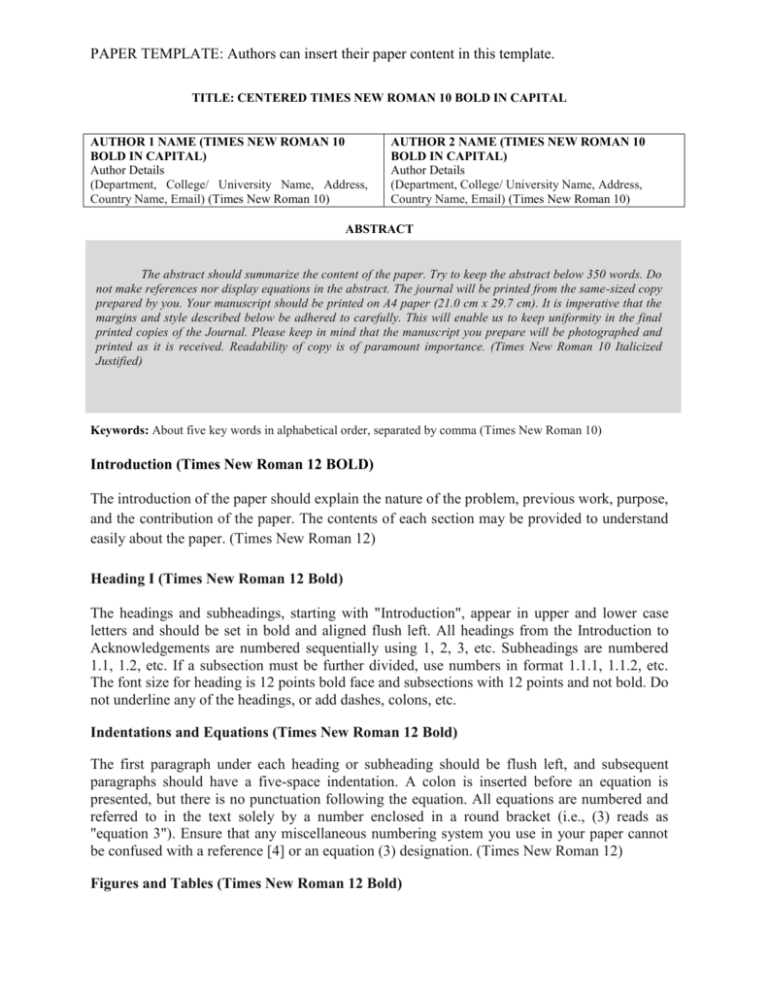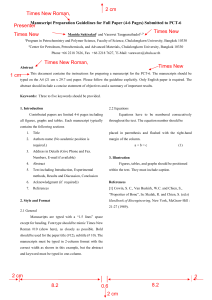MS Word Template
advertisement

PAPER TEMPLATE: Authors can insert their paper content in this template. TITLE: CENTERED TIMES NEW ROMAN 10 BOLD IN CAPITAL AUTHOR 1 NAME (TIMES NEW ROMAN 10 BOLD IN CAPITAL) Author Details (Department, College/ University Name, Address, Country Name, Email) (Times New Roman 10) AUTHOR 2 NAME (TIMES NEW ROMAN 10 BOLD IN CAPITAL) Author Details (Department, College/ University Name, Address, Country Name, Email) (Times New Roman 10) ABSTRACT The abstract should summarize the content of the paper. Try to keep the abstract below 350 words. Do not make references nor display equations in the abstract. The journal will be printed from the same-sized copy prepared by you. Your manuscript should be printed on A4 paper (21.0 cm x 29.7 cm). It is imperative that the margins and style described below be adhered to carefully. This will enable us to keep uniformity in the final printed copies of the Journal. Please keep in mind that the manuscript you prepare will be photographed and printed as it is received. Readability of copy is of paramount importance. (Times New Roman 10 Italicized Justified) Keywords: About five key words in alphabetical order, separated by comma (Times New Roman 10) Introduction (Times New Roman 12 BOLD) The introduction of the paper should explain the nature of the problem, previous work, purpose, and the contribution of the paper. The contents of each section may be provided to understand easily about the paper. (Times New Roman 12) Heading I (Times New Roman 12 Bold) The headings and subheadings, starting with "Introduction", appear in upper and lower case letters and should be set in bold and aligned flush left. All headings from the Introduction to Acknowledgements are numbered sequentially using 1, 2, 3, etc. Subheadings are numbered 1.1, 1.2, etc. If a subsection must be further divided, use numbers in format 1.1.1, 1.1.2, etc. The font size for heading is 12 points bold face and subsections with 12 points and not bold. Do not underline any of the headings, or add dashes, colons, etc. Indentations and Equations (Times New Roman 12 Bold) The first paragraph under each heading or subheading should be flush left, and subsequent paragraphs should have a five-space indentation. A colon is inserted before an equation is presented, but there is no punctuation following the equation. All equations are numbered and referred to in the text solely by a number enclosed in a round bracket (i.e., (3) reads as "equation 3"). Ensure that any miscellaneous numbering system you use in your paper cannot be confused with a reference [4] or an equation (3) designation. (Times New Roman 12) Figures and Tables (Times New Roman 12 Bold) PAPER TEMPLATE: Authors can insert their paper content in this template. To ensure a high-quality illustrations, diagrams and tables MUST be either computer drafted or drawn using India ink. Figure captions appear below the figure, are flush left, and are in lower case letters. When referring to a figure in the body of the text, the abbreviation "Fig." is used. Figures and Tables should be numbered in the order they appear in the text. Table captions appear centred above the table in upper and lower case letters. When referring to a table in the text, no abbreviation is used and "Table" is capitalized. (Times New Roman 12). Figures and tables should be included on a separate page at the end of the paper under the heading “List of Figures” and “List of Tables”. Conclusion (Times New Roman 12 Bold) A conclusion section must be included and should indicate clearly the advantages, limitations, and possible applications of the paper. Although a conclusion may review the main points of the paper, do not replicate the abstract as the conclusion. A conclusion might elaborate on the importance of the work or suggest applications and extensions. (Times New Roman 12) References (Times New Roman 12 Bold) A reference list MUST be included using the following information as a guide. Only cited text references are included. Each reference is referred to in the text by a number enclosed in a square bracket (i.e., [3]). References must be numbered and ordered alphabetically. All references must be complete and accurate. Where possible, include the DOI for the reference in the end of each reference. Examples follow: Journal Papers: [1] Harlow, H. F. (1983). Fundamentals for preparing psychology journal articles. Journal of Comparative and Physiological Psychology, 55, 893-896. Books: [2] Duncan, G. J., & Brooks-Gunn, J. (Eds.). (1997). Consequences of growing up poor. New York, NY: Russell Sage Foundation. Chapters in Books: [3] Bishop, P. O. (1970). Neurophysiology of binocular vision. In J. Houseman (Ed.), Handbook of physiology (pp. 324-366). New York, NY: Springer. Thesis: [4] Chan, D.S. (1978). Theory and implementation of multidimensional discrete systems for signal processing (Doctoral dissertation). Massachusetts Institute of Technology, Cambridge, MA. Proceedings Papers: PAPER TEMPLATE: Authors can insert their paper content in this template. [5] Schnase, J. L., & Cunnius, E. L. (Eds.). (1995). Proceedings from CSCL '95: The First International Conference on Computer Support for Collaborative Learning. Mahwah, NJ: Erlbaum.





